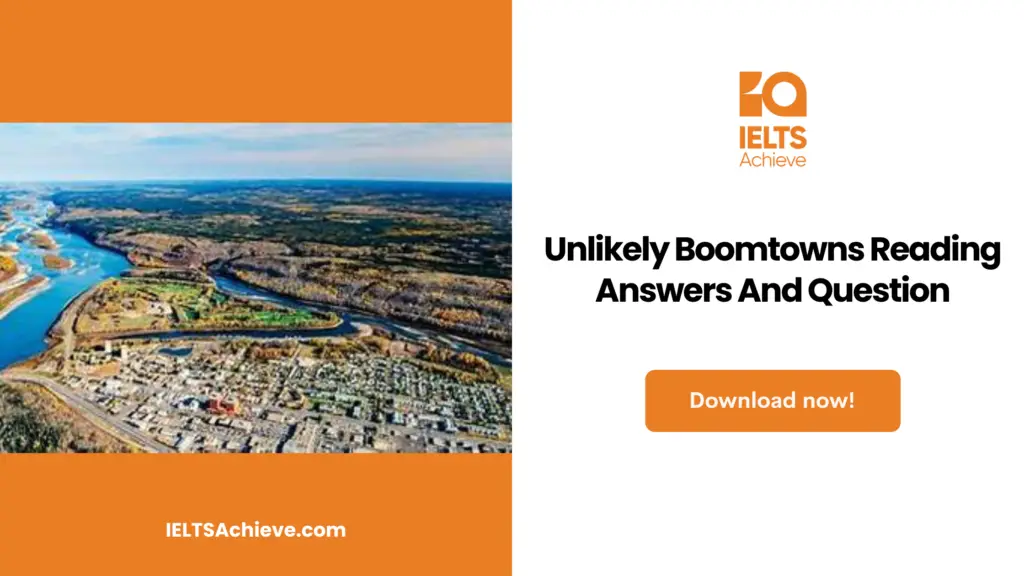The Blog post contains the following IELTS Reading Questions:
- IELTS reading matching features
- IELTS reading sentence completion
- IELTS reading yes/no/not given
Stay informed and prepared for success – Explore our comprehensive Reading Test Info page to get valuable insights, exam format details, and expert tips for mastering the IELTS Reading section.
IELTS reading passage – Unlikely Boomtowns: The World’s Hottest Cities

Unlikely Boomtowns: The World’s Hottest Cities
Unlikely boomtowns are large cities like London, New York and Tokyo that dominate our imaginations. People usually go there to build their fortune, fame and future. These cities have control over their national economies and politics. The last 50 years has been the best time for them. The number of cities with more than 10 million people grew to 20 from just 2. But with all respect to the sci-fi novel writers who have predicted a future of urban giants, their day is over. The population growth rate within a megacity has slowed from more than 8% in the 1980s to 4% over the last 5 years, and these numbers are expected to be static for the next 25 years.
In a few years, more people will live in cities than in small places for the first time in human history. But increasingly, the urban core itself is becoming smaller. Almost 50% of the city dwellers in the world live in metropolises with fewer than 5 lakh residents. Second Cities or exurbs, residential areas outside the cities are booming. Between 2000 and 2015, the world’s smallest cities (with under half a million people) will grow by 23%, while the next smallest (1 to 5 million people) will grow by 27%. This trend is because of the dramatic shifts in the global real-estate bubble, increase in international migration, cheaper transport, new technologies, and the fact that the boomers are reaching retirement age.
The rise of Second Cities has begun naturally from the earlier success of the megacities. In the 1990s, megacities expanded as global markets did. This happened particularly in cities with high-tech or ‘knowledge-based’ industries like finance. Companies offered bigger bonuses, bankers grew richer and the prices of real estate in the world’s most desired cities soared. The result of this was something called ‘gated regions’ as said by demographer William Frey of the Washington-based Brookings, where cities and the surrounding areas became unaffordable for everyone except the rich. After a city reaches a certain size economically, its productivity starts to come down, says Mario Pezzini, head of the regional-competitiveness division of the OECD. He puts the breaking point at about 6 million people, after which expenses, travel times and the occasional chaos lead to a situation where the city centre may be a great place (only for the rich) and the outlying areas become difficult to live and work in’.
One reaction to this phenomenon is further sprawl in prices in the urban core and traditional suburbs. This drives people to distant exurbs with extreme commutes into big cities. As Frey notes, in the major US metropolitan areas, average travelling times have increased two-fold over the last 15 years. Why does a small area become a booming Second City while another fails? The answer lies on whether a community has the money to exploit the forces pushing people and businesses out of the megacities. One key is good public transport connectivity, especially to commercial areas. Although a decade old, Goyang is South Korea’s fastest-growing city in part because it is thirty minutes by subway from Seoul.
Another reason for the growth of Second Cities is the decentralisation of work, driven greatly by new technologies. While financial deals are mostly done now in big capitals like New York and London than ever before, it is also clear that many booming service industries are going towards ‘Rising Urban Stars’ like Dubai, Montpellier and Cape Town. These places have not only improved their internet facilities, but often have technical institutes and universities that produce the talent that is populating growth industries. Consider the urban decentralisation case study of Montpellier, France. Montpellier was like a big Mediterranean village until the 1980s, but one with a strong university, many beautiful villas and an IBM manufacturing unit. Once the high-speed train lines were built, Parisians began coming for weekend breaks. Some purchased houses, creating a critical mass of middle-class professionals who started taking advantage of flexible working systems to do 3 days in Paris, and 2 down South, where things seemed less pressured. Soon, big companies started looking at the area; a number of medical-technology and electronics companies came to town, and IBM put more investment into service businesses there. To cater to the immigrant professionals, the city began to build facilities: an opera house, a tram line to reduce cars in the city center. The result – ‘the city is now full of cosmopolitan business people. It’s a new society’, says French urban-planning expert Nacima Baron.
This implies that Second Cities won’t stay the same. Indeed some countries are actively aiding their growth. For example, Italy is trying to create tourist hubs of towns close to each other with unique buildings and offering different yet complementary cultural activities. Decentralising the policy making power is providing the smaller cities more freedom than ever to shape their destinies. To all these cities: this is your era. Don’t blow it.
Unlock your full potential in the IELTS Reading section – Visit our IELTS Reading Practice Question Answer page now!
Recommended Questions:
Renewable Energy IELTS Reading Question with Answer
Unlikely Boomtowns IELTS Reading questions
Questions 1-4
Look at the following Questions 1-4 and the list of the statements below. Match each statement with the correct one. Write the correct letter A-E on your answer sheet.
NB You may use any letter more than once.
1 Growth rate in megacities in the last 5 years
2 Growth rate of small cities (under half a million) between 2000 and 2015.
3 Percentage of city dwellers in cities with population less than 5 lakhs
4 Growth rate in megacities during 1980s
A 23%
B 25%
C 50%
D 8%
E 4%
Improve your performance in Matching Features questions by clicking here to access our comprehensive guide. Learn how to match specific features or characteristics with the options provided in the IELTS Reading section.
Questions 5 – 9
Complete the sentences below.
Choose NO MORE THAN TWO WORDS AND/OR A NUMBERS from the passage for each answer.
5. The rise of ________ has begun naturally from the earlier success of the megacities.
6. ________ is South Korea’s fastest-growing city in part because it is thirty minutes by subway from Seoul.
7. ________ was like a big Mediterranean village until the 1980s.
8. After a city reaches a certain size economically, its productivity starts to come down, says ________.
9. ________ the policy making power is providing the smaller cities more freedom than ever to shape their destinies.
Enhance your sentence completion skills in the IELTS Reading section. Click here to access our comprehensive guide and learn effective strategies for filling in missing words or phrases in sentences.
Questions 10 – 14
Do the following statements agree with the information given in the Reading Passage?
WriteYES if the statement agrees with the claims of the writer
NO, if the statement contradicts the claims of the writer
NOT GIVEN if it is impossible to say what the writer thinks about this
10. In a few years, more people will live in cities than in small places for the first time in human history.
11. People go to cities to build their fortune, fame and future.12. Cities are affordable to everyone.
13. Cities have large civilisations beneath them.
14. Decentralising the policy making power does not provide more freedom to small cities to shape their destinies.
Want to excel in identifying the writer’s views and claims? Click here to explore our in-depth guide on how to accurately determine Yes, No, or Not Given in the IELTS Reading section.
Unlock your full potential in the IELTS Reading section – Visit our IELTS Reading Practice Question Answer page now!
Recommended Questions:
Renewable Energy IELTS Reading Question with Answer
Unlikely Boomtowns IELTS Reading Answer
1. E. 4%
2. A. 23%
3. C. 50%
4. D. 8%
5. Second Cities
6. Goyang
7. Montpellier
8. Mario Pezzini
9. Decentralising
10. Yes
11. Yes
12. No
13. Not given
14. No

We hope you found this post useful in helping you to study for the IELTS Test. If you have any questions please let us know in the comments below or on the Facebook page.
The best way to keep up to date with posts like this is to like us on Facebook, then follow us on Instagram and Pinterest. If you need help preparing for the IELTS Test, join the IELTS Achieve Academy and see how we can assist you to achieve your desired band score. We offer an essay correction service, mock exams and online courses.

